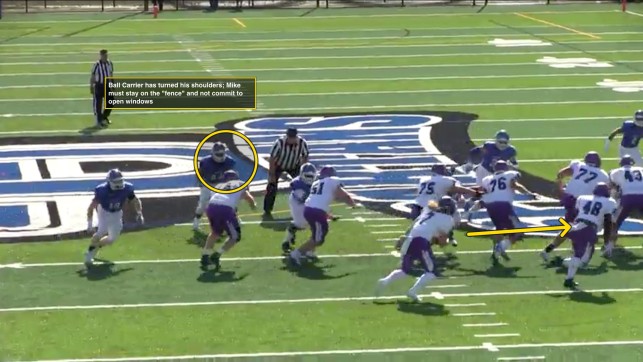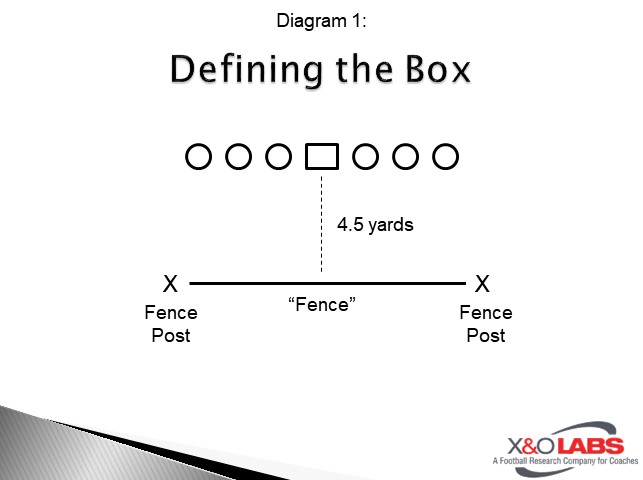By Tim Yourison
Defensive Coordinator / Linebackers
Hamline University (MN)
Twitter: @CoachYourison
Here at Aurora University, we are always trying to get an extra hat to the ball on defense. Whether we are in our three or four down fronts, our linebacker play remains the same. We do not teach them to play one specific gap, but they need to understand where the open gaps, or as we call them windows, are and fit off the ball. This report will go through our linebackers’ fits and techniques and how we teach them.

Linebacker Techniques:
In order to play linebacker here at Aurora, our players must understand the game of chess. We want to move like a rook, not a bishop – we want them to stay square and attack downhill, not turning our shoulders and coming down at an angle. Our linebackers are taught to stay on the “fence” – toes four and a half yards from the line of scrimmage. Since we play both a four down and an odd front, our linebackers need to learn how to be a force player or a box player, regardless if their position is an inside or outside linebacker.
Linebackers at Aurora key offensive linemen to the running back or ball. The coaching point for them is to have their low beams on the lineman and their high beams on the running back. As soon as the ball is snapped the linebackers will take their read step. Read steps for them are a heel pop, then one six inch lateral step in the direction of their lineman, staying at linebacker level, or “on the fence”. After that initial movement, they find the running back or the ball. The reason we have them stay on the fence is three fold. First, it allows them to read and diagnose the play without over committing to one gap. Second, it allows them to stay out of the mess on the line of scrimmage. Third, if a linebacker buries themselves into the line, an offensive lineman is very comfortable engaging and blocking them. If an offensive lineman has to climb and try to block a more athletic player in space, we feel that is an advantage for us.
The “Three F’s”:
Our linebackers are taught three F’s for their run response techniques. If they are a force player the three responses are: Force, Fold and Fence.
Force – Outside action at you
- Make the play – Tackle the ball carrier.
- Force the ball back inside.
- Make the ball go backwards if it continues outside.
Fold – Inside run at you
- Maintain outside leverage on the end man on the line of scrimmage (EMLOS), beware of crack block, stay at fence level.
- Expect ball to bounce to you.
- Once ball is into the line of scrimmage (LOS) inside of you, fold inside.
Fence – Ball is away
- Patience to the fence post – linebacker depth over the tight end or where the tight end would be.
- While moving to fence post, move eyes to opposite tight end or the #2 wide receiver for boot indication.
- No boot indication slide the fence, staying square, looking for open window to shut.
The inside linebackers’ three responses are: Fill, Flow and Fit.
Fill – Back is to you
- Offensive line action is away from you
- Open window, fill it now
- Expect an offensive lineman to climb up to you
Flow – Back is to you
- Offensive line action is away from you
- No open windows, stay at fence level
- Stay on back hip of running back, wait for open window
Fit – Back to away from you or behind the quarterback
- Step with your offensive lineman key (action to you)
- Eyes to running back
- If runningback is downhill now or cutting back, rock back and fill an open window, creating the vice with the other inside linebacker
- If running back cuts the ball back all the way outside, slide the fence looking for an open window
- If the running back stays on a path to your side, fill open window

Once we have taught the three F’s in the classroom we can teach it on the field. Our linebackers practice together because all of the positions could end up being a box linebacker or the force player.
Linebacker Practice Progressions:
Our defensive practice plan is divided in half each day – the first half is a run focus, and the second half in a pass emphasis. We start each individual session with every day drills from stance and first steps to block defeat. We then do a group run fit session before inside run. The second half of individual is spent working pass drops, then coverage fits before 7 on 7. We finish practice with our scout sessions.









